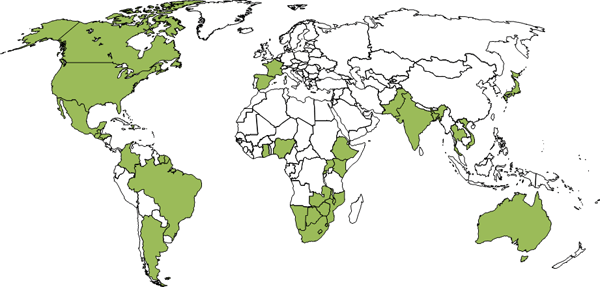Global Fungal Diseases
On This Page
Fungal diseases are a global public health problem. Although fungal diseases can affect anyone, including travelers, they pose a serious threat to people who have weakened immune systems, such as those who have cancer or HIV/AIDS.
Many people at risk for and suffering from fungal diseases live in resource-limited settings, where diagnosis and treatment of these infections can be challenging. These areas of the world often lack the laboratory infrastructure needed to diagnose fungal diseases, and limited availability of antifungal medications means that some patients who have fungal diseases aren’t able to receive the life-saving treatments they need. CDC is working with partners to improve access to fungal diagnostics and antifungal medications around the globe.
Please click here to learn more about fungal diseases.
Who we are
CDC’s Mycotic Disease Branch (MDB) is dedicated to preventing death and disability due to fungal diseases. As one of the only public health groups in the world devoted specifically to the prevention and control of fungal infections, MDB works with domestic and international partners to determine the burden of fungal infections, respond to outbreaks, and address other public health problems related to fungal infections. Click here to learn more about CDC’s Mycotic Diseases Branch.
Where we work
Our branch has assisted in the onsite development, execution, analysis, and publication of numerous studies as well as the implementation, monitoring, and evaluation of several public health programs all over the globe. We work with many international partners in a wide variety of areas, particularly with the assessment and prevention of opportunistic fungal infections among people with HIV/AIDS.
Below is a map of some of the places we’ve worked during the last 5 years, shown in green:

What we’re doing
Cryptococcal meningitis
Cryptococcal meningitis is a deadly brain infection caused by the soil-dwelling fungus Cryptococcus. Worldwide, nearly 220,000 new cases of cryptococcal meningitis occur each year, resulting in 181,000 deaths. Most of the illnesses and deaths occur in sub-Saharan Africa. In some countries with a high HIV prevalence, cryptococcal meningitis causes more deaths than tuberculosis. A simple blood test can detect early cryptococcal disease in HIV-infected persons before they develop meningitis, creating opportunities to prevent this deadly disease.
CDC is assisting several countries in working to prevent deaths from cryptococcal disease by: 1) implementing cryptococcal screening programs, 2) building laboratory capacity to diagnose early cryptococcal infections, and 3) improving access to antifungal medications.
Please click here to learn more about preventing deaths from cryptococcal meningitis.
Histoplasmosis
Histoplasmosis is an infection caused by a fungus that lives in the central and eastern United States, parts of Central and South America, and other parts of the world. Histoplasmosis can affect healthy people, but it is a very serious disease in people who have weakened immune systems. In Latin America, histoplasmosis is one of the most common opportunistic infections among people with HIV/AIDS.
Because delays in diagnosis and treatment of histoplasmosis can lead to increased mortality, CDC and partners in Central and South America are developing new tools to diagnose histoplasmosis and have established laboratory-based surveillance to better understand the burden of this infection.
Please click here to learn more about preventing deaths from histoplasmosis.
Other fungal diseases
Valley fever (coccidioidomycosis)
The fungus that causes valley fever (coccidioidomycosis) lives primarily in the southwestern US and in parts of Mexico and Central and South America. CDC partners with health officials at the local, state, and binational levels to conduct valley fever surveillance and healthcare provider education as part of the Binational Border Infectious Disease Surveillance (BIDS) program.
C. gattii cryptococcosis
CDC is collaborating with medical and public health professionals in Canada and Australia to better understand the epidemiology of cryptococcosis due to Cryptococcus gattii, a fungus that lives in tropical and sub-tropical regions of the world as well as the Pacific Northwest and parts of the US Southeast.
- Page last reviewed: September 30, 2014
- Page last updated: July 27, 2017
- Content source:


 ShareCompartir
ShareCompartir